Punicalagin facts for kids
Quick facts for kids Punicalagin |
|
|---|---|
 |
|
| Properties | |
| Molecular formula | |
| Molar mass | 0 g mol-1 |
| Except where noted otherwise, data are given for materials in their standard state (at 25 °C, 100 kPa) | |
Punicalagin is a special type of natural chemical found in plants. It belongs to a group called ellagitannins, which are part of even larger group known as phenolic compounds. Think of it as a natural ingredient that plants make.
You can find punicalagin in different plants, especially in delicious pomegranates (Punica granatum). It also exists in other trees like Terminalia catappa and Terminalia myriocarpa, and in a plant called Combretum molle, which is also known as the velvet bushwillow and grows in South Africa. These plants are all related and belong to the same plant family.
What is Punicalagin?
Punicalagin is a complex molecule, meaning it's made up of many atoms. Its chemical formula is C48H28O30, which shows it contains a lot of carbon, hydrogen, and oxygen atoms. It comes in two slightly different forms, called alpha and beta punicalagin.
Research and Uses
Scientists have studied punicalagin to understand how it works. They found that punicalagins can dissolve in water. When they are in water, they can break down into smaller natural chemicals, like ellagic acid. This process is called hydrolysis.
In laboratory studies, punicalagins have shown interesting effects. For example, they can act as a carbonic anhydrase inhibitor. This means they can help block the activity of certain enzymes in the body.
Researchers also tested punicalagins on rats. They found that even when rats ate a diet with a good amount of punicalagins for over a month, there were no harmful effects. This suggests that punicalagins might be safe to consume in certain amounts.
See also
 In Spanish: Punicalagina para niños
In Spanish: Punicalagina para niños

